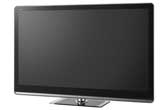
TV-manufacturer Sharp unveiled a new line of LCD TVs earlier this year that is different from anything currently on store shelves. The new Aquos LE models have Sharp's QuadPixel technology included, which the company says will dramatically improve image production and become the standard for the industry.
Every color TV in homes around the world right now uses varying amounts of three colors – red, green and blue – to reproduce the billions of colors in any image. QuadPixel technology adds a yellow pixel, which Sharp says raises the number of reproducible colors into the trillions.
"A yellow sub-pixel enables more light to pass through the system, which requires less intensive backlighting," Sharp explained in a statement to TechNewsDaily. "The obvious advantage here is a more environmentally friendly overall TV system thanks to lower power consumption. One of Sharp’s core principle is prioritizing technologies that are less power consuming and therefore have a smaller overall carbon footprint."
But does QuadPixel technology significantly improve picture quality? Many consumers scrambled to buy high-definition screens because it was obvious to the naked eye how much clearer HD screens were. Sharp repeatedly emphasized during its Quadpixel unveiling the dramatic improvements to image quality that the new colors bring. Will consumers be able to tell the difference between a regular and a QuadPixel TV, or is this just another gimmick?
The difference an extra pixel makes
Color scientists say that, in theory at least, picture quality should improve with an added pixel color.
There is quite a bit of research about using more than red, green and blue (RGB) in display technology, but Sharp's QuadPixel technology marks the first time multi-primary displays (using colors beyond simple RGB) have been put into a mass market TV. Using yellow is just one of several colors that can be used to improve color reproduction.
Get the world’s most fascinating discoveries delivered straight to your inbox.
"Having more than three primaries [RGB] has some benefits: bigger gamut, freedom to reduce observer metamerism and more brightness," said Andreas Kraushaar, color scientist and head of Prepress at the Fogra Graphic Technology Research Association.
That means there are more visible colors the TV can produce, it's easier for the viewer to distinguish those colors regardless of what kind of light is in the room and, the easiest benefit to understand, the colors can be brighter.
Out of those three benefits, the most notable for consumers will be the increased gamut, or wider range of colors. As Sharp pointed out in its presentation at the Consumer Electronics Show in Las Vegas in January, the QuadPixel technology is supposed to improve color reproduction.
However, there are other colors that can be used with RGB pixels to create a wider array of colors than just yellow. So why yellow?
Yellow can help create a more luminous white than R, G, and B alone can, explained Phil Green, Reader in Colour Imaging at the London College of Communication.
"One could increase gamut with other colors – probably to better effect – but yellow would help most with dynamic range," Green told TechNewsDaily.
Basically, this means an additional yellow pixel can make colors and even whites seem brighter, which in turn can improve contrast as well. All this combines to attract the attention of our eyes. In order to make a TV stand out, it needs to have more than just a trillion colors – those colors need to pop.
Sharp has hinted that colors other than yellow may be used in its television sets in the future.
"Naturally there are other colors in addition to yellow that can be added to improve picture quality, and Sharp already publicly demonstrated that capability," the Sharp statement said. "The selection of yellow was the most appropriate given where the market and technology are today [in terms of] price and performance."
The concerns
Even though QuadPixel technology might seem like an improvement over old RGB technology, there are a few nagging issues that call into question whether yellow pixels can really be a leap forward.
First of all, the use of RGB in video imaging has been around for decades and is a fairly well established process. Using RGB+Y, on the other hand, hasn't been applied to commercial LCD production and needs to be handled very carefully in order to work.
"The yellow needs to be more saturated than any combination of red and green and this is difficult to achieve," said Mark Fairchild, at the Rochester Institute of Technology's (RIT) Center for Imaging Science. "If that is not achieved, then the yellow is nothing but marketing."
Another potential problem is display resolution. A TV needs to pack 1080 pixels across the width of its screen in order to display an HD signal. Each pixel contains red, green and blue. Adding yellow means each pixel must be made larger and takes up more room. This could be why Sharp is only producing QuadPixel TVs in relatively large sizes, though there are many other considerations, such as manufacturing costs and consumer demand.
Adding an additional color also makes it harder to translate images designed for RGB display into an image that appears correctly on an RGB+Y display. The yellow in each pixel would make translation from an RGB signal to a QuadPixel display quite complicated. It can be done, Fairchild said, but "the transformation from RGB to RGB+Y [must be] done carefully. If it is not, then the color could be worse."
The human perspective
The real test, of course, is whether the human eye likes what it sees. At the CES 2010 show, Sharp had a QuadPixel display set up next to an RGB model, cycling through the same images simultaneously for comparison, and the difference was discernable to this reporter's eye. Yellows definitely seemed to be more saturated.
The downside: Sometimes the overly saturated yellows almost made the image look cartoonish. Other colors, meanwhile, didn't seem that much better nor even brighter.
Some of the other CES attendees who stopped by the Sharp booth were also underwhelmed. The majority of reactions were similar: Yeah, the yellows look yellower, but it's not earth-shattering. So what?
Even the experts seem undecided. "It's not necessarily a gimmick, but it's hard to say it's worth it," RIT's Fairchild said. "Personally, if I was making the display, there are easier ways to make more significant improvements: more saturated RGB primaries, more luminance, more contrast, less noise, more pixels, etc."
While there is some solid science behind what Sharp is doing, the QuadPixel technology may end up being yet another feature that most consumers won't notice, just like the contrast wars HD TVs have been having for years.
- Flat-Panel TVs: 10 Things to Know Before You Buy
- 7 Gadgets That Changed the World
- 10 Profound Innovations Ahead


